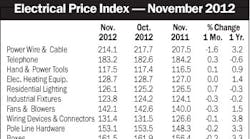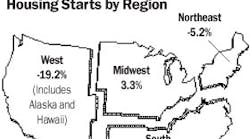Latest from Mag
People - Dec 21, 2012
Obituaries - Dec 21, 2012
November EPI Index Shows No Change
Housing Starts Dip 4% in November
Electrical Marketing - December 21, 2012
Around the Industry - Dec 21, 2012
The editors of Electrical Marketing and Electrical Wholesaling had plenty of news stories to cover in 2006. Here is part two of our picks for the most important news and trends of the past year. Part One ran in EM’s Dec. 8 issue.
Housing market hits the wall.
What goes up must come down. After a joy ride that lasted several years and set residential construction records year after year, the housing market blew a few tires and left homebuilders holding tens of thousands of unsold, empty new homes in many of the same markets that provided so much of the excitement. The lonesome echo of overbuilding can be heard throughout the streets of new housing developments in overheated metropolitan areas in Florida, Arizona, Las Vegas, Southern California and other parts of the Sunbelt. The crash hurts the many businesses that depend on the housing market, and it will take at least a year for builders to sell existing inventory and for prices to drop in many markets to the point where people can actually afford to buy homes again. But it’s all part of the game in the housing market, where cyclical swings are common. Economists are already predicting that a rebound will begin in 2008.
Commercial construction to sustain industry growth in 2007.
While the housing market got hammered in 2006, commercial construction enjoyed one of its best years in quite some time. National office-vacancy rates are at their lowest point in years, and the light-commercial construction that tends to lag housing spurts is well underway in what were the most active housing markets. One of the beauties of the electrical wholesaling industry is the balance it enjoys between major market segments. The three biggest segments — residential, commercial and industrial construction — all march to the beat of their own drums, with their own market drivers. They are all interrelated, in that residential work leads commercial work and industrial work tends to follow the other segments. But it’s pretty rare for these three segments to be going great guns or in a down cycle at the same time. While the residential market helped lead the electrical industry through the early parts of this economic recovery earlier in the decade, it’s the commercial market, and to a lesser degree the industrial market, that will sustain growth next year.
Energy market gathers momentum.
The market drivers that create demand for energy-saving electrical products became an increasingly visible factor in the electrical industry in 2006. Utility-rebate programs are very much alive and are a valuable marketing tool distributors, contractors and other industry buying influences can use to stimulate sales of energy-efficient lamps, ballasts, lighting controls, reflectors, lighting fixtures, motors and drives. The tax breaks the federal energy bill offers for the design of energy-efficient buildings are a tangible resource building owners can tap into. The Leadership in Energy and Environmental Design (LEED) standards promoting the development of “green” buildings are now producing healthier workplaces that help the environment. Consider the ever-more efficient lighting products that hit the electrical market in greater numbers every year. Manufacturers, distributors and reps can use the momentum these market drivers have created to overcome the cost-first focus that stymied sales of energy-efficient electrical products in the past.
March continues toward a more digital future for the electrical biz.
It has taken several years for The Industry Data Exchange Association (IDEA), Arlington, Va., to convince distributors and manufacturers they can enhance profitability, data accuracy and transaction efficiency by using its package of online services. But IDEA is gaining some real momentum, as more distributors, manufacturers and reps discover the benefits of transmitting data through the IDX2 value-added network (VAN), managing data through the IDW2 industry data warehouse (IDW), and synchronizing and cleansing data through the Data Audit and Certification (DAC) process
